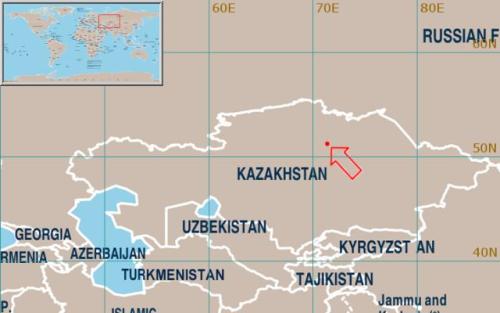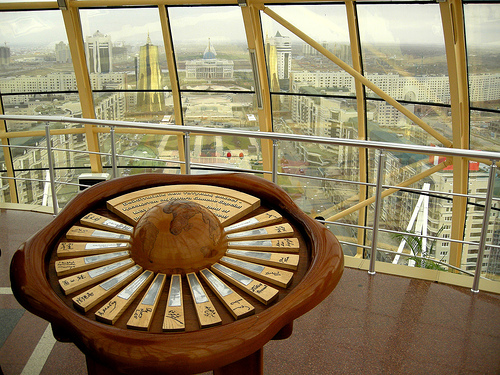kazakhstan
(...) Sacha Baron Cohen has upset Kazakhstan with his character Borat Sagdiyev. The foul-mouthed fictional TV reporter will now face a fierce Kazakh warrior on a mission of courage and romance. President Nazarbayev hopes that Nomad, a film about the struggle of Kazakh tribes to expel Mongol invaders, will improve his nation’s reputation (...)
ein aufschlussreicher abend mit borat also. nicht dass der film besonders lustig gewesen wäre - ausserdem hatte er (auch in seiner scheinbar parodistischen verkehrung) kaum etwas mit kazakhstan zu tun. der hauptschauplatz sind die usa, der drehort teilweise rumänien, die filmmusik von balkan - hypes wie goran bregovic oder partizani geprägt. dass sich die regierung von kazakhstan zu einer offiziellen reaktion und einem gegenfilm hat hinreissen lassen: das ist eher ein armutszeichen für die offizielle politik denn eine erfolgsmasstab für den film borat. nun wäre der film natürlich rasch zu vergessen, wäre er nicht ausdruck eines trends, der den scheinbar aufgeschlossenen und toleranten, aber zynisch und herabsetzend agierenden reisenden ergriffen hat.

osteuropa, der balkan, die nachfolgestaaten der sowjetunion in zentralasien: sie gerinnen vor dem hintergrund von ignoranz, unwissen und angstlust zur freakshow des aufgeklärten travellers, konsumiert am besten in filmen wie borat oder in jener ach so lustigen buchserie von jetlag. sich rasch von reisemühsalen in mehrfach gedemütigten ländern (kommunismus, schockkapitalismus, autokratie und korruption) erholend, findet man/frau entspannung in der stigmatisierung des fremden. zudem darf man/frau sich so elegant dem mainstream von urlaubserfahrungen eines massenpublikums entziehen und spezielle erfahrungen lukruieren. ost - freakshows können in einer mischung aus linkem übermut, intellektueller hochnäsigkeit und dem überlegenheitsgefühl von westlichen betrachtern konsumiert werden und bestätigen die eigenen vorurteile. sich als etwas besonderes fühlen, ach ja, wie gieren wir danach. ein wenig theorie gefällig? (ENG)
(...) A freak show is an exhibition of rarities, "freaks of nature" — such as unusually tall or short humans, and people with both male and female secondary sexual characteristics — and performances that are expected to be shocking to the viewers. Heavily tattooed or pierced people have sometimes been seen in freak shows, as have fire-eating and sword-swallowing acts (...)
in unserem fall wurde das konzept der freakshow auf länder, kulturen und lebensstile ausgedehnt, auf die da im osten, die zu spät gekommenen und zurück gebliebenen. die ost - freakshow macht den betrachter somit zu etwas ganz besonderem. mit kulturbezogener parodie, mit humor und lächeln hat das freilich wenig zu tun. es evoziert höchstens brech-lachen und hinterlässt äusserst üble gerüche. der film ist schlicht und ergreifend: unappettitlich.

in astana. neurasia blog is enthusiastic about it, sauseschritt cannot share this passion:
(...) This blog relies on Norman Foster’s professional engagement in Kazakhstan. We previously reported about Foster’s contributions in making Astana a true architectural capital of the 21st century: The huge yurt-like tent structure, Khan Shatyry and the Pyramid of Peace are both rather unorthodox additions to the capital’s skyline.
Now Foster and Partners will add another landmark to the sprawling city, this time even more spectactular as I find (...)
for the ones, who wanna know and see more about sir norman foster, sauseschritt found a suiting link !

sometimes good things happen and the world seems to be a rational place. when sauseschritt searched a pack of peanuts in his fridge to watch the news in his hotel in astana, he found: condoms ..... they are part of the standard room equipment.
a world bank report analyses:
(...) The Eastern Europe and Central Asia Region (ECA) is experiencing one of the world’s fastest-growing HIV/AIDS epidemics. According to UNAIDS, in 2005, 270,000 people in ECA became newly infected with HIV. This brings the number of people living with HIV/AIDS to approximately 1.6 million, a number that has increased 20-fold in less than 10 years. An estimated 62,000 people lost their lives to HIV/AIDS this year alone.
The majority of people living with HIV are in the Russian Federation and Ukraine, where the combination of injecting drug use and sex work is fuelling the epidemic.
The patterns of the epidemic are changing in several countries, with sexually transmitted HIV cases making up a growing share of new diagnoses, for example in Kazakhstan, Belarus and Moldova. Across the region, young people are disproportionately affected, with an estimated 75 percent of reported infections between 2000 and 2004 in those under the age of 30 (...)
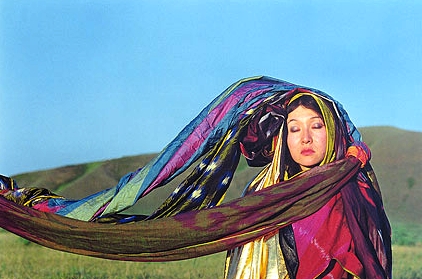
und wem all diese beiträge zu kasachstan zu triste sind, der mag sich ja in der kunstszene, und vielleicht bei almagul melibaeva umtun. ein kurzvideo namens on the road hier.
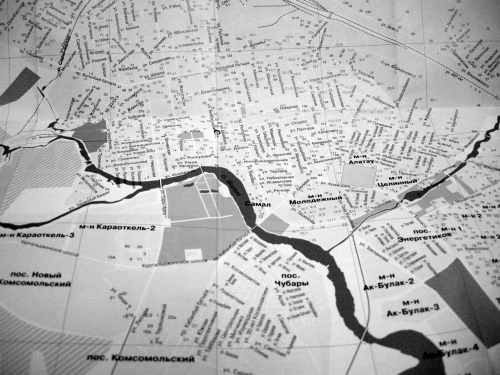
als sauseschritt in der rezeption des hotels grand park esil nach einem plan der stadt astana fragt, wird er ernsthaft, rasch und sehr zuvorkommend versorgt. sogar der standort des hotels wird von der rezeptionistin gewissenhaft eingezeichnet. in vorbereitung einer tour zu den manifestationen städtebaulichen grössenwahns, fragt sauseschritt nach dem bayterek turm. ein freundliches aber auch ein wenig spöttisches lächeln: haben wir noch nicht auf dem plan.
während dieser fein säuberlich die strassen des alten viertels nördlich des flusses ishim verzeichnet, gähnt kartographische leere südlich desselben, dort wo es fast alle geschäftsleute und touristen hinzieht, ins zentrum von kazakhstans macht, verwaltung und wirtschaftsboom. diese stadtpläne sind noch zu zeichnen, man wartet mit der kartographie offenbar noch bis 2030, wo nach heutigem stand alle grossvorhaben in diesem stadtteil abgeschlossen sind.
gestern (1999) noch rund 300.000, heute 600.000 und morgen (2030) erwartete 1.000.000 einwohner/innen und dies an einem ort, der als zweitkälteste stadt der welt gilt und die von nicht mehr als endloser steppe, wind und wetter umgeben ist.
ethno-postmodernism in in an albert speer pattern, so bezeichnet der englische wikipedia artikel den merkwürdigen stil des verwaltungszentrums. man nehme am besten einen sehr erfahrenen taxifahrer, um zu einer der adressen in diesem teil der welt zu gelangen, denn selbst gewiefte berufsfahrer von big W finden ihren weg kaum. am fusse des lolli pop stehend, wie die bewohner/innen astanas den bayterek turm bezeichnen, sieht sauseschritt hinauf in richtung ministeriumsstadt, senat, parlament und präsidentenpalast - und fühlt sich unversehens an die vergangenheit in bukarest erinnert. wie überhaupt: weit entfernt ist dieser architektonische alptraum nicht von europäischen vorbildern entfernt. la defense, ja - nur wird dort eher der mammon geld, nicht wie hier, der grosse präsident und seine kleine nation vergöttert.
zwischen all diesen geschmacklosigkeiten hin und her wankend, sieht sauseschritt die zukunft dieser stadt, wenn all die bodenschätze versiegt sind. riesige eisdome, angenagt von kälte, wind und eis, irgendwo in der steppe kazakhstans, gleich dort wo sibirien beginnt. tiere und menschen meiden den ort. inzwischen werden zukunftsvisionen geschmiedet.
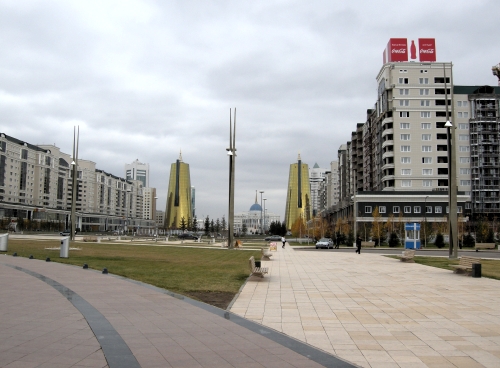
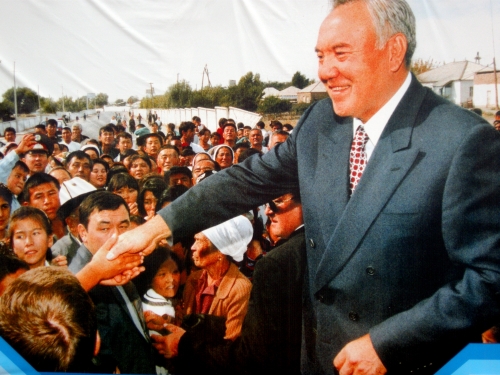
one week before sauseschritt arrived in astana, the country faced a severe shortage of bread in Astana and other cities of kazakhstan. this is, as the economist put it, a huge embarrassement for the kazakh leadership after its (expected) victory in the august elections.
the recent raise in prices for bread (30 per cent) and doubling for sugar, flour and sunflower oil recalled the darkest days of hyperinflation of post soviet days, writes the economist. between 1991 and 1995 in kazakhstan real GDP fell by 39 %, exports collapsed and poverty grew to amounts, which had not been experienced in the former soviet union for a long time. this past economic crisis is well remembered by the kazakh population although economic growth (but not poverty reduction) seems to be working compared to other countries of the central asian region.
experiencing a remarkable economic recovery (led by the prospering oil and mining sectors) and facing the growing wealth of a narrow segment of the population, its hard to understand for kazakh citizens that a shortage of basic food becomes reality.
the economist warns:
(...) a home-made food crisis is politically far more dangerous to the countries authoritarian leadership than a financial meltdown, which can be partly blamed on wobby international markets. the elderly complain that even during the harsh years under Joseph Stalin they always had bread (...)
by the way, international markets (increased world-market prices) were of course a serious reason for the bread shortage not only in kazakhstan but also in other emerging economies. even russia established price control meachanisms to secure food prices and froze prizes by mid october. Shouldn´t we rather talk about securing foor for the population instead of blaming countries for soviet style interventions in the economy? one would expect that a country with a prospering economy to have enough financial resources to counteract those shortages immediately. due to the political danger the government immediately has undertaken measures to avoid future shortages. if you are interested in the multifacetted reasons of the so called bread crisis in kazakhstan, read the cacianalyst!
officially the shortages are now declared being over - at least in hotels and other places, where sauseschritt stayed during his visit in astana. but this does not say anything. its a big O mission and big O missions mostly are safe, comfortable and far away from the social reality of the majority of people.
